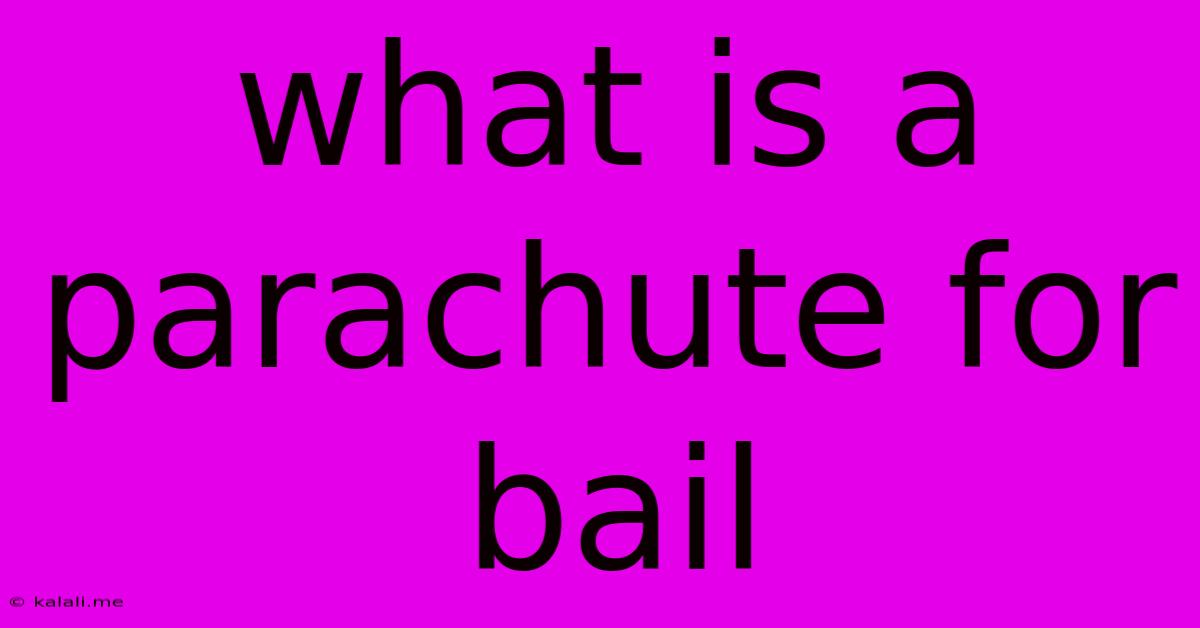What Is A Parachute For Bail
Kalali
Jun 04, 2025 · 3 min read

Table of Contents
What is a Parachute for Bail? Understanding Bail Bonds and Collateral
A parachute for bail isn't a literal parachute you'd use for skydiving. Instead, it's a colloquial term referring to collateral or assets used to secure a defendant's release from jail pending trial. This article will explain what bail is, how a bail bond works, and the role of collateral in securing someone's release.
What is Bail?
Bail is a system where a defendant can be temporarily released from jail after being arrested, by paying a certain amount of money. This money is not a fine; it's a guarantee that the defendant will return to court for their trial. If the defendant appears for all scheduled court appearances, the bail money is returned. If they fail to appear (a "failure to appear" or FTA), the bail is forfeited. The amount of bail is determined by a judge and is based on factors such as the severity of the crime, the defendant's criminal history, and the risk of flight.
How Bail Bonds Work
Most people can't afford to pay the full bail amount. This is where a bail bondsman comes in. A bail bondsman is a licensed professional who posts bail on behalf of the defendant for a fee. This fee is typically a percentage of the total bail amount, usually between 10% and 15%. The bondsman assumes the risk that the defendant might not return to court.
The "Parachute": Collateral for Bail Bonds
This is where the "parachute" analogy comes into play. Since the bail bondsman is taking on a significant financial risk, they often require collateral from the defendant or their family to secure the bond. This collateral acts as a safety net or "parachute" – a backup plan – in case the defendant fails to appear in court. The types of collateral that can be used vary, but might include:
- Real Estate: This is often the most valuable and readily accepted form of collateral. The bondsman places a lien on the property, meaning they can seize it if the defendant doesn't show up for court.
- Vehicles: Cars, trucks, boats, and other vehicles can also serve as collateral. Similar to real estate, the bondsman will place a lien on the vehicle.
- Other Assets: Depending on the bail amount and the bondsman's policy, other assets might be accepted, such as savings accounts, stocks, bonds, or valuable personal possessions.
Why Collateral is Important
Collateral significantly reduces the risk for the bail bondsman. By requiring collateral, they are more likely to recover their investment if the defendant flees. This makes it easier for individuals to obtain bail, even if they lack the funds to pay the full amount upfront.
Consequences of Failing to Appear
If a defendant fails to appear in court after being released on bail, the bail is forfeited, and the bondsman is responsible for the full bail amount. This is why the bondsman carefully assesses the risk before posting bail and often requires significant collateral. The defendant also faces serious legal consequences, including the issuance of a warrant for their arrest and potentially increased penalties for their original offense.
In Conclusion
The term "parachute for bail" highlights the crucial role of collateral in the bail bond process. It's a safety net, protecting both the defendant and the bail bondsman. While the system has its complexities and criticisms, understanding the role of collateral helps illuminate how individuals can secure release from jail while awaiting trial.
Latest Posts
Latest Posts
-
Big Mosquito Looking Bug Not Crane Fly
Jun 05, 2025
-
400 Amp Meter Base With 2 200 Amp Disconnects
Jun 05, 2025
-
Briggs And Stratton Getting Too Much Fuel
Jun 05, 2025
-
What Does Wife To Boot Mean
Jun 05, 2025
-
Why Does Frodos Sword Glow In Moria
Jun 05, 2025
Related Post
Thank you for visiting our website which covers about What Is A Parachute For Bail . We hope the information provided has been useful to you. Feel free to contact us if you have any questions or need further assistance. See you next time and don't miss to bookmark.